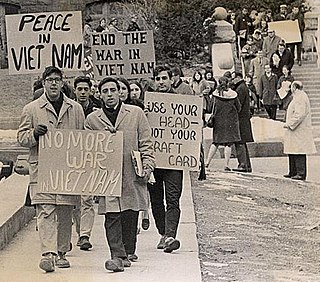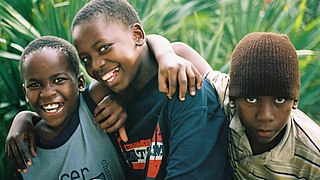A generation gap or generational gap is a difference of opinions and outlooks between one generation and another. These differences may relate to beliefs, politics, language, work, demographics and values. The differences between generations can cause misunderstandings, but it is possible for generations to overcome their differences and maintain functional relationships.

Youth culture refers to the societal norms of children, adolescents, and young adults. Specifically, it comprises the processes and symbolic systems that are shared by the youth and are distinct from those of adults in the community.
Acculturation is a process of social, psychological, and cultural change that stems from the balancing of two cultures while adapting to the prevailing culture of the society. Acculturation is a process in which an individual adopts, acquires and adjusts to a new cultural environment as a result of being placed into a new culture, or when another culture is brought to someone. Individuals of a differing culture try to incorporate themselves into the new more prevalent culture by participating in aspects of the more prevalent culture, such as their traditions, but still hold onto their original cultural values and traditions. The effects of acculturation can be seen at multiple levels in both the devotee of the prevailing culture and those who are assimilating into the culture.

Cultural identity is a part of a person's identity, or their self-conception and self-perception, and is related to nationality, ethnicity, religion, social class, generation, locality, gender, or any kind of social group that has its own distinct culture. In this way, cultural identity is both characteristic of the individual but also of the culturally identical group of members sharing the same cultural identity or upbringing. Cultural identity is an unfixed process that is continually evolving within the discourses of social, cultural, and historical experiences. Some people undergo more cultural identity changes as opposed to others, those who change less often have a clear cultural identity. This means that they have a dynamic yet stable integration of their culture.
Cultural assimilation is the process in which a minority group or culture comes to resemble a society's majority group or assimilates the values, behaviors, and beliefs of another group whether fully or partially.
The Hispanic paradox is an epidemiological finding that Hispanic Americans tend to have health outcomes that "paradoxically" are comparable to, or in some cases better than, those of their U.S. non-Hispanic White counterparts, even though Hispanics have lower average income and education, higher rates of disability, as well as a higher incidence of various cardiovascular risk factors and metabolic diseases.
In sociology, people who permanently resettle to a new country are considered immigrants, regardless of the legal status of their citizenship or residency. The United States Census Bureau (USCB) uses the term "generational status" to refer to the place of birth of an individual or an individual's parents. First-generation immigrants are the first foreign-born family members to gain citizenship or permanent residency in the country. People beyond the first generation are not "immigrants" in the strictest sense of the word and, depending on local laws, may have received citizenship from birth. The categorization of immigrants into generations helps sociologists and demographers track how the children and subsequent generations of immigrant forebears compare to sections of the population that do not have immigrant background or to equivalent generations of prior eras.
In sociology and cultural studies, cultural dissonance is a sense of discord, disharmony, confusion, or conflict experienced by people in the midst of change in their cultural environment. The changes are often unexpected, unexplained or not understandable due to various types of cultural dynamics.
The interactive acculturation model (IAM) seeks to integrate within a common theoretical framework the following components of immigrants and host community relations in multicultural settings:
- acculturation orientations adopted by immigrant groups in the host community;
- acculturation orientations adopted by the host community towards special groups of immigrants;
- interpersonal and intergroup relational outcomes that are the product of combinations of immigrant and host community acculturation orientations.
A culture gap is any systematic difference between two cultures which hinders mutual understanding or relations. Such differences include the values, behavior, education, and customs of the respective cultures. As international communications, travel, and trade have expanded, some of the communication and cultural divisions have lessened. Books on how to handle and be aware of cultural differences seek to prepare business people and travelers. Immigrants and migrant laborers need to learn the ways of a new culture. Tourists can also be confronted with variants in protocols for tipping, body language, personal space, dress codes, and other cultural issues. Language instructors try to teach cultural differences as well.
Bicultural identity is the condition of being oneself regarding the combination of two cultures. The term can also be defined as biculturalism, which is the presence of two different cultures in the same country or region. As a general term, culture involves the behaviors and belief characteristics of a particular social, ethnic, or age group. Within culture, we have cultural effects, which are the shared behaviors and customs we learn from the institutions around us. An example of a cultural effect would be how an individual's personality is strongly influenced by the biological and social norms he is exposed to. Another cultural effect would be that in some societies it would be more acceptable to dress or act in a certain way.
A culturagram is a family assessment tool used in the practice of social work which was first introduced by Fordham University professor, Dr. Elaine Congress.
Second-generation immigrants in the United States are individuals born and raised in the United States who have at least one foreign-born parent. Although the term is an oxymoron which is often used ambiguously, this definition is cited by major research centers including the United States Census Bureau and the Pew Research Center.
In the United States, members of the same immigrant family often have differing access to resources. Much literature focuses on inequality between families, but inequality often exists within families as well. Though within-family inequality is not unique to immigrant families, the processes of migration and assimilation into American society provide new channels through which such inequality may emerge.

Nearly half of all refugees are children, and almost one in three children living outside their country of birth is a refugee. These numbers encompass children whose refugee status has been formally confirmed, as well as children in refugee-like situations.
Asian Americans have historically been perceived as a "model minority", experiencing few health problems relative to other minority groups. Research within the past 20 years, however, has shown that Asian Americans are at high risk for hepatitis B, liver cancer, tuberculosis, and lung cancer, among other conditions. Asian American health disparities have only gained focus in the past 10 years, with policy initiatives geared towards promoting healthcare access to Asian Americans rising to prominence even later. Asian Americans are defined as Americans of Asian ancestry and constitute nearly 5% of American's population as of 2003, according to the U.S. Census Bureau. Yet, the Asian American population can hardly be described as homogenous. The term applies to members of over 25 groups that have been classified as a single group because of similar appearances, cultural values, and common ethnic backgrounds. The Asian Americans commonly studied have been limited primarily to individuals of Cambodian, Chinese, Filipino, Hmong, Japanese, Korean, Lao, Mien, or Vietnamese descent.
Culture defines how people view the world and certain phenomena. Culture also appears to influence the way people experience depression. An individual's experience with depression can vary from country to country. For example, a qualitative study revealed that some countries did not recognize post-natal depression as an illness; rather, it was viewed as a state of unhappiness that did not require any health interventions.
The Filipino American identity comprises principles from both the Philippines and the United States. Although the meaning of identity differs from one individual to another, the fundamental factors are the same. History, genetics, socio-economic status, culture, and education are all indirect factors that influences the identity of an ethnic group; thus, they are also reflective of a group's health beliefs and practices.

The immigrant paradox in the United States is an observation that recent immigrants often outperform more established immigrants and non-immigrants on a number of health-, education-, and conduct- or crime-related outcomes, despite the numerous barriers they face to successful social integration.
Adverse childhood experiences (ACEs) are identified as serious and traumatizing experiences, such as abuse, neglect, exposure to violence, substance use, and other harmful events or situations that occur within a child's household or environment. Unfortunately, exposure to ACEs within the child's community is all too common in low-income households and neighborhoods, with close to 43% of children in the United States (U.S.) living in low-income families. ACEs were first identified by the Centers for Disease Control and Prevention (CDC) and Kaiser Permanente's Adverse Childhood Experiences Study conducted from 1995 to 1997, where ACEs were examined and correlated with later-life well-being. With one in four children experiencing or witnessing a potentially traumatic event, children who grow up in an unsafe environment are at risk for developing adverse health outcomes, affecting brain development, immune systems, and regulatory systems.




